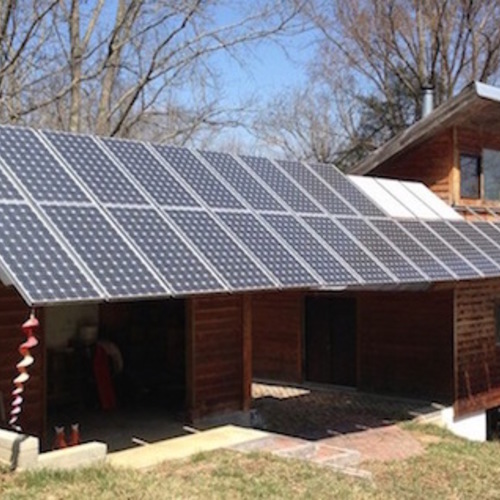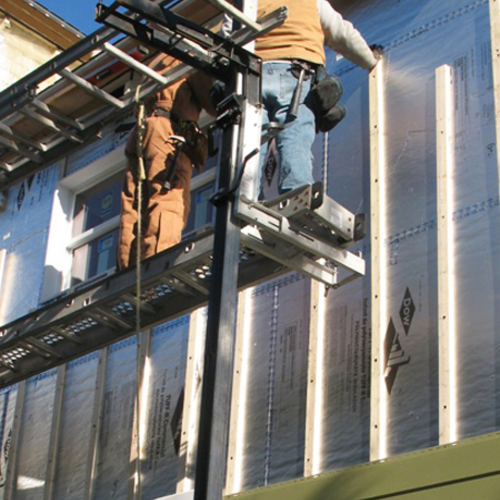
An analysis by the American Council for an Energy-Efficient Economy finds that energy efficiency and solar make complementary energy and carbon reductions in new home construction, but when budgets are tight, efficiency needs to come first. Throughout the United States, energy efficiency is more cost-effective. Each month, it delivers $4 to $32 in net savings while rooftop solar alone can cost up to $14.
With the U.S. building stock estimated to add a net average of 1.4 million homes each year, states will need to minimize their energy use and greenhouse gas emissions by focusing on effective building codes and standards. For the U.S. residential sector, building codes like the International Energy Conservation Code (IECC) and voluntary labels like Energy Star provide cost-effective guidance for insulation, windows, lighting, and heating and cooling equipment to construct efficient and sustainable homes.
Our research paper and summary show that the energy efficiency measures found in these codes and standards are more cost-effective than an equivalent amount of energy generated from photovoltaic (PV) panels. Based on these results, we conclude that new homes must first be built efficiently for maximum cost-effectiveness. Solar panels can then be added to further reduce carbon emissions and help homes meet zero-energy targets.
States adopting residential building codes need to consider these results when assessing proposals to allow solar PV to be substituted for energy efficiency measures. Requirements like efficient windows and wall insulation help ensure long-term cost-effective energy savings for the homeowner. Solar panels can cost more, and may be dependent on financial arrangements. Even if a homebuilder can save upfront costs through financing options tied to government incentives, the homeowner will not necessarily save money in the long term.
The following graphic compares the monthly net costs for energy efficiency to meet the 2015 IECC code and equivalent solar PV generation, for cities in Climate Zones 2-6, an area reaching from the hot and humid South to the cold North. Net monthly efficiency cost savings are even greater for homes built to Energy Star standards. These results do not include government incentives and assume a traditional mortgage rather than other financing.

Of course, cost-effectiveness isn’t the only consideration when installing efficiency measures or solar panels. Both reduce heat-trapping carbon emissions and harmful air pollution. Plus, a well-insulated, efficient home loses and gains heat more slowly than a drafty one, helping to retain comfortable temperatures during emergency power outages. Similarly, when PV is paired with battery storage, it can provide a homeowner with electricity during a power outage.
Efficiency measures work around the clock
When it comes to improved health and comfort, insulation combined with high-efficiency windows and air conditioning systems have an advantage over PV. They also typically reduce peak power demand, whereas solar power can reduce peak demand mid-day, but this benefit fades as the sun sets, so the grid needs to ramp up quickly to meet demand. On the other hand, installing rooftop solar panels is a great way to signal a clean energy commitment to the world, while efficiency measures like insulation and efficient water heaters typically remain hidden.
Solar energy and energy efficiency are both key parts of our energy future. For example, solar and efficiency together can help meet ambitious zero-energy building targets, like California’s Residential New Construction Zero Net Energy (ZNE) Action Plan.
When it comes to constructing a new home throughout most of the United States, our study shows that energy efficiency is the most cost-effective choice. Once a home achieves compliance with energy codes through energy efficiency, then solar can help meet the remaining energy load.
Christopher Perry is a senior analyst in the Buildings Program at the American Council for an Energy-Efficient Economy. This post originally appeared in the ACEEE News & Blog section.
Weekly Newsletter
Get building science and energy efficiency advice, plus special offers, in your inbox.















11 Comments
> energy efficiency is the most cost-effective choice.
But at some point, beyond code energy efficiency becomes less cost effective then PV solar. Even more so with utility scale PV (they can do twice a much for the same price).
But the dialog needs to shift away from energy efficiency and to environmental impact efficiency.
Utility scale PV isn't directly paid for by the homeowner, so there's really no "price" exposure for that solution.
Their study is relative to IECC 2015 prescriptive R-values/U-factors vs. a path to code compliance via predicted energy use "Energy Rating Index" as outlined in section 406, which could be met at using PV in lieu of a fully prescriptive-compliant building envelope. At current small scale PV pricing it's closing in on being cheaper to meet compliance on an ERI basis in many instances, especially when the PV is third-party owned (=no upfront cost to the homeowner for the PV.)
https://codes.iccsafe.org/content/IECC2015/chapter-4-re-residential-energy-efficiency
They used IECC 2006 prescriptives as the basis for cost effectiveness analysis to compare upgrading to IECC 2009, 2012, 2015 (prescriptive) or Energy Star 3.1 in a new build vs. adding $3/watt (all-in, installed cost) solar the IECC 2006 compliant house, and (no surprise) IECC 2015 wins.
Solar is now hitting under $2.75/watt (unsubsidized) as a national average (https://openpv.nrel.gov/ ), and in a few other first-world countries with competitive and well developed markets (and in some US locations) it's hitting the $1.50/watt (before subsidy), so it's no an insane issue to consider as PV pricing continues to fall in the US. Should there be an adjustment to the ERI for subsequent versions of the IECC?
It would have been nice for the article itself to explain what Dana just explained. The cost effectiveness of efficiency measures is highly dependent on the starting point.
Fully agreed. The economics are always changing -- as are the old truisms in energy efficiency. Depending on the project, I would argue that split system heat pumps can deliver larger and more cost effective savings in some homes than retrofitting higher levels of insulation. A bit upsetting to the purists, I know!
>"I would argue that split system heat pumps can deliver larger and more cost effective savings in some homes than retrofitting higher levels of insulation. A bit upsetting to the purists, I know!"
It would be useful to actually read the analysis/white paper describing the study (https://aceee.org/sites/default/files/solar-and-ee-042519.pdf ), in which case it would have been apparent that heat pumps were the primary non-gas heating systems included in the analysis.
On page 16 it states:
"In addition, ENERGY STAR divides housing into two types—electric and gas—where the former uses an electric air-source heat pump/electric water heater and the latter uses a gas furnace/electric air conditioner/gas water heater. To simplify our final results, we calculated the costs and energy savings for both types of homes and then combined them, according to estimated shares of heating systems from the IECC determinations. For instance, in the West North Central census division (where St. Louis is located), homes are estimated to be about 40% electric heat pump, 57% gas heating, and 3% electric furnace. "
Dana, I would argue that there probably shouldn't be an adjustment due to lower PV cost, at least in most of the country, for houses that are grid connected. I say this because the likely adjustments that would be made would be to increase the energy use of the reference design, while keeping total energy use basically the same. If you take that adjustment to the extreme you could have completely uninsulated houses that need large amounts of grid supplied power during the winter.
I could probably agree that adjustment could be made when the the highest energy use month is net zero purchased energy. Additionally I could agree if the grid has some crazy increase in energy storage.
I think the IECC needs to support not just using as little energy as possible but using it in a way that fossil fuel (and all heat generating) plants that we must have run with a high duty cycle.
Side benefits of energy efficiency measures not mentioned here is improved comfort and indoor air quality which leads to improve health (assuming construction or improvements are done properly). While comfort is not tangible nor easily measurable, improved health has specific financial benefits in terms of fewer lost days of work and lower medical costs.
Carl,
That seems intuitively true, but do we have any data that shows energy upgrades in new construction actually lead to measurable improvements in the occupant's health?
> benefits of energy efficiency measures not mentioned here is improved comfort
I'm sure I could design a house that is more energy efficient and noticeably less comfortable - disproving "more energy efficient means more comfortable". Even using design features that are commonly recommended on GBA.
Done equally properly, don't expect any noticeable comfort improvement from better than current code energy efficiency.
Malcom - There is not a lot of empirical evidence of the health impacts but there is some, including this Seattle study: https://nchh.org/research/king-county-healthy-homes/. When I was still renovating homes and doing pilot projects for the EarthCraft renovation program, we had several clients to told us that their allergies improved or disappeared after air sealing, insulating, and installing ventilation. There are other studies planned or in process so I expect we will see more information in the next few years. J
Jon - if you read my comment, my point is that "construction or improvements are done properly", comfort is improved. I agree that it is very easy to screw up a building so that it is efficient and uncomfortable. I would add that proper maintenance is critical as well.
Log in or create an account to post a comment.
Sign up Log in